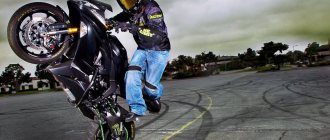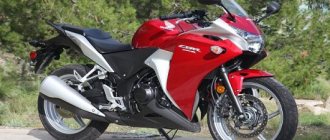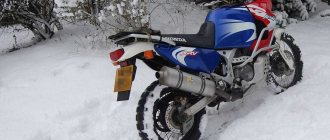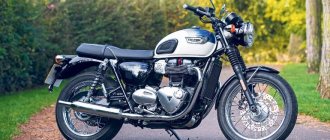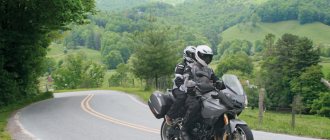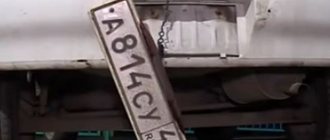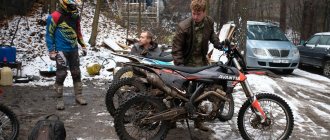They say that every motorcyclist has fallen at least once in his life. What to do when you realize that a fall is inevitable? Let's discuss.
Falls can generally be divided into two groups:
- Controlled fall
- Unexpected sharp drop
In the first case, this is the result of your resistance. You either tried to save the situation until the last minute, or the speed was low enough to maneuver. You understood that you were falling and prepared for it.
In the second case, we are talking about an accident, wheel drift or interference from a foreign object.
In a controlled fall, you have a few seconds to realize what is happening, prepare yourself mentally, and possibly calculate your next actions. Sometimes, the pilot even manages to simply jump off the motorcycle in order to minimize his own injuries.
If you instantly fall from a motorcycle, you have to realize what is happening already while lying on the asphalt, flopping head over heels in the wake of the motorcycle.
Relaxed, but in control of the body
The logical reaction of the body is grouping. The right thing to do when falling is to group yourself, pull your head towards you, and clasp your hands near your chest or head. One thing. If at the moment of the fall you are tense like a string, then the likelihood of injury increases. Have you ever wondered why drunk people sometimes fall better than the most seasoned fighters, do not break anything when they suddenly go to the ground, and are able to fall asleep in any position that would make the most experienced yogi jealous? Their bodies are relaxed under the influence of alcohol.
Your task is to keep the tuck, but not to meet the blow from the asphalt with straight arms or legs. Even a professional fighter, when falling somersault, will never fall on a straight arm or leg; he will absorb the energy of the blow due to the movement of his body after touching the ground. Dissipates energy throughout the body. The task of the group is not only to escape from direct attacks to vulnerable places, but also to absorb the blow with the whole body at once.
Problems for motorcyclists:
- Speed limit violation;
- Feverish operation of the brakes - blocking the front or rear wheel;
- Turning is a disease of most motorcyclists: high speed when entering a turn, leaning, incorrect throttle operation, pilot panic;
- Passion for overtaking in oncoming traffic. Here motorcyclists run the risk of being caught by cars turning left;
- Inability and fear to perform high-speed maneuvers in extreme situations;
- Insufficient experience of riding on treacherous road surfaces for motorcyclists (sand, wet asphalt, cuts in asphalt);
- Traveling with a passenger;
- And a bunch of other problems associated with inexperience...
Behavior after a fall
After the fall, movement begins by inertia. I don’t know about you, but I personally have always been bothered by cars speeding behind me. What if someone doesn’t have time to slow down?
When it comes to what to do after a fall, the starting point is the cause of your accident. If you fall and fly over a motorcycle, then your misfortune will be a pile of metal rushing after you. And rest assured, its mass is enough to catch up with you. Therefore, if you fall in front of a motorcycle, you need to move out of the way of the motorcycle as quickly as possible.
If you are in a slippery ride and the motorcycle is sliding in front of you, burning out beautiful sparks with its expensive body kit, you need to increase your own grip as much as possible. In other words, slow down the inertia of movement as much as possible.
If you are being dragged behind a motorcycle, try to turn around so that you can move your feet forward. This way, you will still have a chance to brake with your feet and even if you hit a motorcycle, absorb the collision. When you slide forward headfirst, you have no way to control your fall, and the impact of meeting an obstacle is unlikely to be pleasant.
Try to avoid sliding into somersaults. When you start being tossed around and thrown around on the asphalt, you risk getting new bruises. Moreover, it is much more difficult to control a fall when moving head over heels than when sliding.
LIST OF COMMON CAUSES OF MOTORCYCLE ACCIDENTS
The car turns left in front of you
The most common type of accident on the road. The driver either doesn't see you or misjudges your speed when turning in front of you at the intersection. Inattention, absent-mindedness, blind spots and banal psychology are to blame - the driver perceives only the absence of cars, and not the presence of a motorcycle.
How to avoid:
It's simple - you just need to pay close attention to the road. Your job as a motorcyclist is to develop your “sixth sense.” Look for any signs that the driver is about to turn - a car is at an intersection waiting to turn, there is space in traffic near an intersection, driveway or parking lot. In any situation, slow down, use your brakes, and prepare to avoid obstacles. Yes, yes, all you need to do is perceive the car as a serious and immediate threat to your life. You also need to take into account objects outside your field of vision. A free space in traffic does not mean that you will be the first to take that place, because you may simply not see anyone because of your blind spots. And once again - in case of danger - always be ready to evade the threat!
And once you've identified the threat, you can internally work through all the severity levels of that threat.
- Is the driver able to see you?
- Are your car's side mirrors obstructing your visibility?
- Trees?
- Signs?
- Does the driver really see you?
- How are the other cars positioned on the road?
- What is their speed?
- Where do their wheels point?
Look at the wheels, not the car - they will give you the first clue to solving this problem. Always be aware of those behind you or next to you. If you need to dodge, you always need to know where exactly! After the first analysis of the situation on the road, think about your capabilities. What is the road surface like? Will your bike be able to handle the full force of the brakes or are you going to lock them up - You know how to use ABS (anti-lock braking system), right?
Under no circumstances should you “put the motorcycle down.” Your best chance of survival is to remove as much speed as possible before impact, and you should do your best to keep the bike completely upright, using engine braking and rear brake braking. Even if you only have time to lose 20 or 30 km/h, this can give you a big advantage to go home with only bruises and, in principle, survive.
Skid on a dirt road
You get into a skid in an area of sand, gravel, leaves, horse manure, or whatever else comes your way. You spun your front wheel and skidded.
How to avoid:
don't brake right away! Try to ride at the same pace until your reaction and ability to act effectively matches your ability to act effectively. On the road, “slow in, fast out” is an extremely important rule. Enter the skid angle as wide as possible to increase your view of the obstacle and at a speed that is comfortable for you. You can speed up a little when coming out of a skid as soon as you see the opportunity.
Rear wheel braking is a more advanced skill that you will need to learn and practice on the court before using the skill in an urban environment.
Ideally, the plan to avoid an accident when skidding on a rough road is as follows:
- ALIGN BIKE
- BRAKING IN A STRAIGHT PATH BY CLAMPING BOTH BRAKES AT THE SAME TIME
- ONLY THEN ENABLE THE CLUTCH AND CHANGE THE SPEED TO NEUTRAL, FIRST OR SECOND.
Yes, in some situations this may be inconvenient, but, nevertheless, try to adhere to these rules, because life and health come first!
There is another advanced skill that is a little counter to rules-loving America, but is taught to advanced police riders abroad. It is about maximizing vision by using the entire width of the road, regardless of lane. Vision = safety = speed. Again, learn this from a professional before trying it yourself.
You entered the turn too fast...
...and now this turn is unexpectedly prolonged, or you simply did not expect such a long turn.
How to avoid:
don't be a fool! Drive as fast as you can, looking for and using visual cues such as posts and signs to judge the direction of the road, even if that road disappears on a blind climb.
If you find yourself in a corner too fast, the best solution is to trust the bike and try to get through the corner. The motorcycle is probably more capable of this than you! Lean the bike as far as possible, look at the point where you want to go, remain calm and smooth in your control. Do not apply the brakes, apply the gas, or do anything that could affect the motorcycle's stability and cause loss of traction. Don't panic if your knee or any part of the bike touches the ground - just try to maintain that lean angle, look for the exit of the turn and pull yourself out of there.
This is another situation where rear wheel braking can be a real help, allowing you to safely slow down while already in a corner. Please note that braking with the rear brake during a turn straightens the motorcycle and the turning trajectory is straightened. Do not use the rear brake, but apply the brakes, otherwise you may drive off the road.
A car changes lanes in front of you
You are calmly driving in your lane, and suddenly, a car in another lane suddenly turns into the space you are occupying. Remember that our tiny motorcycles easily fit into the blind spots of cars, and drivers of moving cars do not psychologically perceive motorcycles as an equivalent vehicle (here you go, snobs!).
How to avoid:
Remember where your blind spots are and spend as little time as possible in those areas. If you can see the driver's eyes in their mirrors, then they also have the opportunity to see you (but remember that still doesn't always mean they can see you - Ed.).
Avoid situations where lane changes become more likely. Is traffic on the roads slowing down, with one lane moving faster than others? Motorists usually want to be in this lane. Don't be where they want to be.
Look for signs of a car changing lanes:
- turn signals
- turned out wheels
- a car pulled to the edge of its own lane while the driver checks his mirrors
- drivers moving heads
Remember all this, be careful and everything will be fine!
A car hit you from behind
You stop at a stop sign (intersection, intersection, to let a family of ducks or a child pass), and the driver behind you does not see you or does not try to see you and drives right into you at high speed. The most common car accident is a Fender-Bender (in America this is usually a minor incident, but not so serious that you cannot leave the scene of the accident on your own - Ed.)
or in Russian - the cars “kissed”.
And it can kill a motorcyclist!
How to avoid:
use cars as your own “softening zone”
I'll explain what it is - it's usually that part of the car, especially the outermost front and rear, that is designed to bend slightly in a collision and absorb the brunt of the impact.
One car stopped at a multi-lane traffic light with even more cars behind it? Lean forward a little and you will be safe from any subsequent blows. On the dividing line between a line of cars this works just as well.
Are there any free “softening zones”? Change lanes to the side, move away from the center of the lane, quickly turn the brake light on and off by pressing the brake lever, keep your right hand on the gas. Pay attention to what is happening behind you, and be prepared to jump away if it appears that someone is about to start driving into you.
Also, this advice works in situations where visibility is poor, drunk driving is prevalent (bars around you and their customers who left there at 1 am), or when stops are unexpected, for example: at pedestrian intersections, on very busy streets and such “sudden events” as ducks crossing the road.
Your friends are idiots
We all know how it goes - a group goes for a walk when one of them suddenly stops or something. His friend was too busy, daydreamed and hit him from behind. If this happened to us, it could happen to anyone.
How to avoid:
make sure everyone is aware of proper driving etiquette and knows how to ride in a staggered manner. You'd be surprised how many people don't know about this simple technique. This increases visibility, and keeping the bikes out of line with each other means that such lag, even if temporary, will not result in a collision. Choose smart buddies or ride alone.
You have locked the front brake
A deer (nice girl, policeman...) stopped traffic. You brake sharply, and... already lying on the asphalt, watching your front wheel.
How to avoid:
learn to use the front brake. It may seem counterintuitive, but the front brake is the most powerful and complex component on your motorcycle. It can reduce your speed much faster than your engine.
If you're just learning to ride and haven't mastered the skill yet, or you've bought a new motorcycle, then you need to learn it - find a big empty area and start practicing. From a minimum speed (say 45 km/h), start braking at a certain point, and then repeat ad infinitum until you have reduced the braking distance to as short as possible. You should be able to feel the tire at the very edge of the toe and the rear wheel lifting off the ground. Then start practicing at increasingly higher speeds until you can reliably and safely use your motorcycle's maximum stopping power.
Opening car door
The largest gap in traffic is usually between the line of parked cars and the lane of active traffic. So, you make your way through it, when suddenly some “Alyosha-I-Don’t-Look-Nowhere” opens his door right in front of you.
How to avoid:
never, hear, never drive between an active lane and parked cars. Not only because of the doors opening, but also because pedestrians can unexpectedly jump out, cars slowly crawl out in reverse, and for millions of other reasons. Do not do that. And if you suddenly find yourself in a similar situation - when someone opens the door - follow all the recommendations above and brake as hard as possible. Even if a collision is unavoidable, losing even a small portion of your speed will greatly help keep you safe.
Motorcyclists call the area next to parked cars the "death zone" - and this is no coincidence.
Slippery road
Precipitation! These cold, wet and unexpected surprises...and it became slippery. Listen to Douglas Adams and don't panic.
How to avoid:
does your motorcycle have decent treads or were you stupid and decided that the track is a running track covered with rubber?? Hint: of course not! As long as you use normal rubber on your bike and those tires are not worn out, you will be surprised at how well the bike performs in harsh conditions. Just slow down and be as smooth as possible through turns.
On wet surfaces, for example, manhole covers and road markings become super, super slippery, and you have to watch out for oil spills on the road. Look for rainbow spots and avoid them. If it's only recently rained, an hour or so is the most treacherous time - the rain has picked up all the oily liquids and other crap from the sidewalk. Treat yourself to a hot cup of coffee and wait out the downpour so that all this debris can be washed away by the rain.
Also beware of limited visibility in rain, fog and inexperienced car drivers - they don't seem to understand that slippery conditions require longer braking distances and earlier braking.
Renowned British racing driver Ron Haslam advocates maintaining revs while wet. The idea is that if your rear wheel starts to spin, you'll open the throttle less, allowing you to regain traction much faster than if you were doing 25 mph in 6th with the throttle wide open.
The most common cause of motorcycle accidents!
According to the 1981 Hurt Report—the largest study ever conducted on motorcycle causation—alcohol is a factor in 50% of all motorcycle accidents.
How to avoid this:
Don't ride a motorcycle drunk.
When the fall is over
When your fall and slide is over, do not rush to jump up. You don’t yet know what injuries you have received. Sudden movements can cause great damage to you. It may be that the pilot suffers a fracture from the impact, but due to the shock of pain, he does not immediately realize it. If he immediately gets up to run towards the motorcycle or someone, the fracture will develop into a complicated case.
When the fall has stopped, freeze for a couple of minutes. Your body needs this time to feel what happened, to receive feedback from each muscle. Start with a simple check of your well-being, stretch your fingers and toes, can you feel them? Then hands and feet, elbows and knees. From small muscles to large ones, from limbs to the center of the body. Try to take a deep breath, is there any sharp pain in your lungs?
Only after analyzing how you feel can you rise SLOWLY.
Falling off a motorcycle is as controllable as any difficult maneuver. Another question is, at what speed are you falling? Here, as in a turn, less speed means more control. Don’t lose your composure, trust your body, try to imagine where the motorcycle is moving relative to you so as not to collide with it. And of course, take care of yourself.
How to prevent a fall?
There is no need to mention the motorcycle driving style, since an experienced owner of two-wheeled equipment knows the consequences of strong bends, sharp braking and hitting large bumps. It is better to consider additional devices that prevent the driver from falling in an emergency. The limit bars are installed on the side of the motorcycle. They do not allow you to select an excessive angle of inclination that threatens to fall with dangerous consequences. Protecting your motorcycle from falling also helps ensure the safety of the motor and other important components in case of slips.
An alternative to arches are sliders made of high-strength plastic. They are not able to prevent a fall, but they do leave enough space to allow your hand to be pulled out from under the motorcycle. In addition, sliders reduce friction and reduce the severity of damage to motorcycle equipment.
